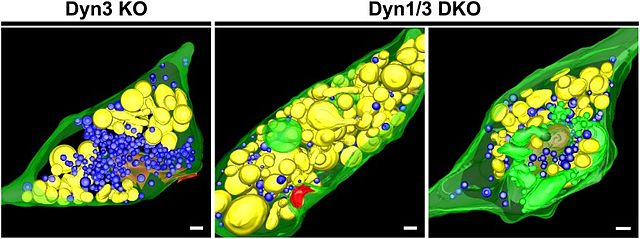Vesicular monoamine transporter
The vesicular monoamine transporter (VMAT) is a transport protein integrated into the membranes of synaptic vesicles of presynaptic neurons. It transports monoamine neurotransmitters – such as dopamine, serotonin, norepinephrine, epinephrine, and histamine – into the vesicles, which release the neurotransmitters into synapses, as chemical messages to postsynaptic neurons. VMATs utilize a proton gradient generated by V-ATPases in vesicle membranes to power monoamine import.
A Hydrogen atom from the inside of the vesicle binds, inducing a conformational change in the transporter
The conformational change induced by the hydrogen atom binding enables the monoamine binding to the active transport site
A second hydrogen atom binds from inside the vesicle to the transporter inducing another change
The monoamine is released inside the vesicle and the two hydrogen atoms are released into the cytosol and the transport process starts over again.
In a neuron, synaptic vesicles store various neurotransmitters that are released at the synapse. The release is regulated by a voltage-dependent calcium channel. Vesicles are essential for propagating nerve impulses between neurons and are constantly recreated by the cell. The area in the axon that holds groups of vesicles is an axon terminal or "terminal bouton". Up to 130 vesicles can be released per bouton over a ten-minute period of stimulation at 0.2 Hz. In the visual cortex of the human brain, synaptic vesicles have an average diameter of 39.5 nanometers (nm) with a standard deviation of 5.1 nm.
Synaptic vesicle
Primary hippocampal neurons observed at 10 days in vitro by confocal microscopy. In both images neurons are stained with a somatodendritic marker, microtubule associated protein (red). In the right image, synaptic vesicles are stained in green (yellow where the green and red overlap). Scale bar = 25 μm.






